Nissan Juke Service and Repair Manual : Fuel tank
Exploded View
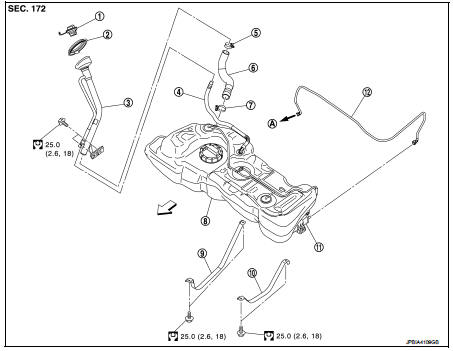
1. Fuel filler cap
2. Grommet
3. Fuel filler tube
4. Vent hose
5. Clamp
6. Fuel filler hose
7. Clamp
8. Fuel tank
9. Fuel tank mounting band (RH)
10. Fuel tank mounting band (LH)
11. EVAP canister
12. EVAP canister hose
A. To fuel tube
 : Vehicle front
: Vehicle front
 : N·m (kg-m, ft-lb)
: N·m (kg-m, ft-lb)
Removal and Installation
WARNING:
Be sure to read “General Precautions” when working on the fuel system. Refer to
FL-30, "General Precautions".
REMOVAL
• Drain fuel from fuel tank if necessary. Refer to FL-33, "Removal and Installation".
• Perform work on level place.
1. Remove RH rear wheel.
2. Perform steps 2 to 7 of “REMOVAL” in “FUEL LEVEL SENSOR UNIT, FUEL FILTER AND FUEL PUMP
ASSEMBLY” on fuel level sensor unit, fuel filter and fuel pump assembly. Refer to FL-33, "Removal and Installation".
3. Remove sub muffler. Refer to EM-166, "Removal and Installation".
4. Remove insulator on vehicle side located above center and sub muffler.
5. Remove floor under covers (RH, LH) Refer to EXT-25, "Exploded View".
6. Move parking brake cable (1) from the lower face of fuel tank. Then remove clips for parking brake cable.
7. Disconnect fuel filler hose at fuel tank side.
1 : Filler tube
2 : Filler hose
8. Remove vent hose at RH rear wheel well side
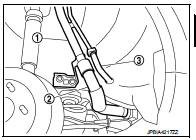
9. Remove EVAP canister hose (1) at front side of fuel tank (2).
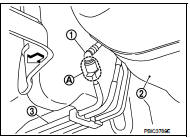
3. : Centralized under-floor piping
A. : quick connector
 : Vehicle front
: Vehicle front
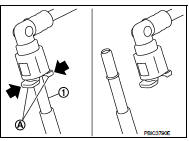
• Remove quick connector in the following procedures.
- Pinch quick connector square-part (A) with your fingers, and pull out the quick connector (1) by hand.
- If quick connector and tube on vehicle are stuck, push and pull several times until they move, and pull out.
CAUTION:
• The tube can be removed when the tabs are completely
depressed. Never twist it more than necessary.
• Never use any tools to disconnect quick connector.
• Keep the resin tube away from heat. Be especially careful when welding near the tube.
• Prevent acid liquid such as battery electrolyte, etc. from getting on the resin tube.
• Never bend or twist resin tube during installation and disconnection.
• To keep the connecting portion clean and to avoid damage and foreign materials, cover them completely with plastic bags or something similar.
• Never insert plug, preventing damage on O-ring in quick connector.
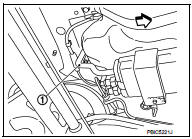
10. Remove EVAP hose (1) in the back for fuel tank side.
 : Vehicle front
: Vehicle front
11. Remove quick connectors (A) from the EVAP canister (1).
2. : EVAP canister hose
12. Disconnect EVAP hose and vent tube at the position shown in the figure.
• Instruction for quick connector of EVAP hose and vent tube, refer to the following:
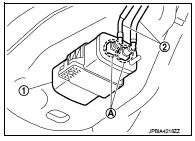
Vent hose
• Remove quick connector in the following procedures.
- Pinch quick connector square-part (A) with your fingers, and pull out the quick connector (1) by hand.
- If quick connector and tube on vehicle are stuck, push and pull several times until they move, and pull out.
CAUTION:
• The tube can be removed when the tabs are completely
depressed. Never twist it more than necessary.
• Never use any tools to disconnect quick connector.
• Keep the resin tube away from heat. Be especially careful when welding near the tube.
• Prevent acid liquid such as battery electrolyte, etc. from getting on the resin tube.
• Never bend or twist resin tube during installation and disconnection.
• To keep the connecting portion clean and to avoid damage and foreign materials, cover them completely with plastic bags or something similar.
• Never insert plug, preventing damage on O-ring in quick connector.
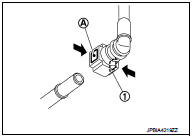
13. Support the center part of fuel tank (1) with transmission jack (B).
CAUTION:
Securely support the fuel tank with a piece of wood (A).
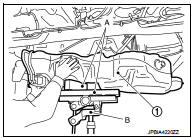
14. Remove fuel tank mounting bands (RH and LH).
15. Lower transmission jack carefully to remove fuel tank while holding it by hand.
CAUTION:
Fuel tank may be in an unstable condition because of the shape of fuel tank
bottom. Never rely on
jack too much. Be sure to hold tank securely.
INSTALLATION
Note the following, and install in the reverse order of removal.
Fuel Tank
1. Temporarily tighten bolts [except (4)] in numerical order as shown in the figure.
A : Under view
 : Vehicle front
: Vehicle front
2. Tighten bolt (4) to specified torque, pressing fuel tank in the
direction (  ) shown in the
) shown in the
figure.
3. Tighten bolts [except (4)] to specified torque in the reverse order as shown in the figure.
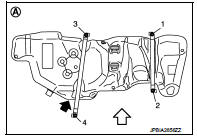
Fuel Filler Hose
• Surely clamp fuel hose insert fuel filler hose to the length below.
Fuel filler hose : 35 mm (1.38 in) The other hose : 25 mm (0.98 in)
• Be sure hose clamp is not placed on swelled area of fuel filler tube.
• Install fuel filler hose to fuel tank, paying attention to install mark. Marking faces downward.
• Tighten fuel filler hose clamp so that the remaining length of screw thread becomes to the following.
Fuel filler tube side : 8 - 12 mm (0.28 - 0.43 in) Fuel tank side : 5 - 9 mm (0.25 - 0.35 in)
EVAP canister hose
1. Check connections for damage or foreign material.
2. Align the matching side connection part with the center of shaft, and insert connector straight until it clicks.
3. After connecting, pull out quick connector and centralized under floor piping by hand. Check connections are secure.
A : Pull
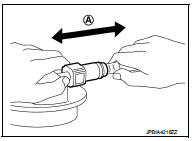
Inspection
INSPECTION AFTER INSTALLATION
Use the following procedure to check for fuel leakage.
1. Turn ignition switch “ON” (with engine stopped), and check connections for leakage by applying fuel pressure to fuel piping.
2. Start engine and rev it up and check there are no fuel leakage at the fuel system tube and hose connections.
 Fuel level sensor unit, fuel filter and fuel pump assembly
Fuel level sensor unit, fuel filter and fuel pump assembly
Exploded View
1. Fuel tank
2. Rock ring
3.
Fuel level sensor unit, fuel filter and
fuel pump assembly
4. O-ring
: Vehicle front
: Always replace after every
disassembly.
: N·m (kg-m, ...
 Evap canister
Evap canister
Hydraulic Layout
EVAPORATIVE EMISSION LINE DRAWING
1. EVAP canister purge volume control
solenoid valve
2. Resonator
3. EVAP canister
NOTE:
Do not use soapy water or any type of solvent whil ...
Other materials:
Power supply and ground circuit
AUDIO UNIT
AUDIO UNIT : Diagnosis Procedure
1.CHECK FUSE
Check for blown fuses.
Is inspection result OK?
YES >> GO TO 2.
NO >> Be sure to eliminate cause of malfunction before installing new fuse.
2.CHECK POWER SUPPLY CIRCUIT
Check voltage between audio unit harness connect ...
Hazard function
Component Function Check
1.CHECK FUNCTION
1. Select “MULTI REMOTE ENT” of “BCM” using CONSULT-III.
2. Select “FLASHER” in “ACTIVE TEST” mode.
3. Check that the function operates normally according to the following
conditions.
Is the inspection result normal?
YES >> Hazard warning lam ...
Precaution Necessary for Steering Wheel Rotation after Battery Disc
NOTE:
• Before removing and installing any control units, first turn the ignition
switch to the LOCK position, then disconnect
both battery cables.
• After finishing work, confirm that all control unit connectors are connected
properly, then re-connect both
battery cables.
• Always use CONS ...
